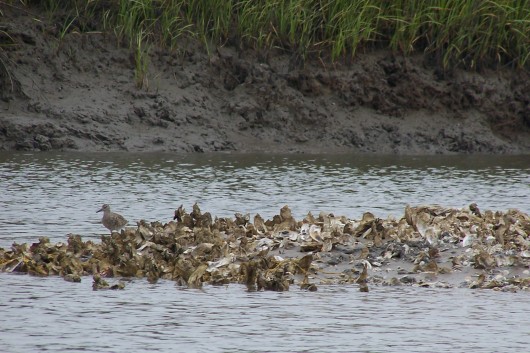
Living Shoreline Treatments address erosion in lower energy situations by providing long-term protection, restoration or enhancement of vegetated shoreline habitats through strategic placement of plants, stone, sand fill and other structural or organic materials. Living Shoreline Treatments do not include structures that sever the natural processes and connections between uplands and aquatic areas.
See Natural and Structural Measures for Shoreline Stabilization Link
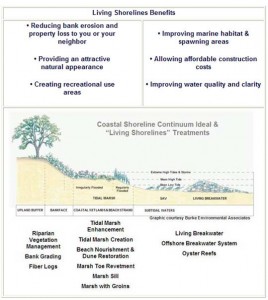
figure taken from http://ccrm.vims.edu/livingshorelines/
What are Living Shorelines?
Many shorelines are stabilized with hardened structures (e.g., bulkheads, revetments, concrete seawalls). For example in Mobile Bay and in other states the percent of shorelines that are armored can exceed 60-80% (e.g., see Douglass, S. L. and B. H. Pickel. 1999. The tide doesn’t go out anymore – the effect of bulkheads on urban shorelines. Shore and Beach 67:19-25). What is worse is that these man-made physical structures can even increase the rate of local erosion, while removing natural processes along these critical fringing shoreline habitats that so often habitat for so many species. Many federal and state agencies are working to implement more natural bank stabilization approaches often called “living shorelines.” The approach can employ plants, sand, oyster shell (often in bags), organic materials (e.g., biologs made of jutte), concrete (castles) material-filled structures (OysterBLKs™) or other recycled or natural structural materials (e.g., fossil shell, granite, concrete) to provide shoreline protection and if properly constructed enhance upland (landward) eroding invaluable habitats such as marshes and mangroves. It typically works best in lower energy habitats than those that have higher wave energies.
- Living Shorelines websites
- Rethinking Living Shorelines
- New Report Questions Hard-Edged ‘Living Shorelines’ in Estuaries
- Armoring vs. Living Shorelines
- TX Living Shoreline Brochure
- CBF Living Shoreline document
FL Living Shorelines Site
This website (http://floridalivingshorelines.com/) provides information on Living Shorelines techniques to control erosion around coastal Florida. The purpose of this website is to make it easier for public and private property owners to evaluate more environmentally-friendly, and cost-effective approaches to shoreline stabilization. The aim is to show how the use of plants and other natural materials might help protect eroding shorelines from wave and storm damage in coastal FL bays and estuaries. The Living Shorelines techniques described can be used in many low wave energy areas vs. traditional coastal armoring approaches such as seawalls and bulkheads. The aim is to also enhance natural habitat for fish, birds, and other wildlife – creating living, thriving shorelines instead of barriers. Explore the site. It includes contacts around the state, information on permitting, examples with lots of pictures and info also. There is all sorts of information, see the Living shoreline research or the Sea level rise, climate change and blue carbon sections in the Resource Section dropdown (for example webinars such as “Preparing for climate changes with living shorelines”).
2015 California Coastal Armoring Report
Melius, M.L., and M.R. Caldwell, with others contributions, 2015. California coastal armoring report: Managing coastal armoring and climate change adaptation in the 21st Century, Environment and Natural Resources Law & Policy Program, Stanford Law School, 41pp. See pdf and link.
In response to erosion and storms, CA has constructed seawalls, revetments, and other coastal armoring structures along more than 110 miles (>10%) of California’s coastline, with >33% in southern California, reducing beach area, habitats, and beach access. Armoring has also exacerbated erosion to adjacent properties thereby stimulating even more armoring, and has had an overall negative impact on environments. Beaches and other ecosystems may inevitably disappear due from armoring.
Coastal Review (Online) for NC
Living Shorelines Get a Boost in N.C.
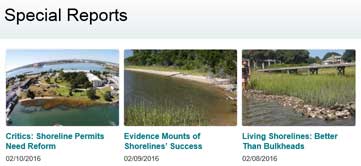
Three reports by Trista Talton:
Part 1- Living Shorelines: Better Than Bulkheads, 2/08/16
Link
Part 2- Evidence Mounts of Shorelines’ Success, 2/09/16
Link
Part 3- Critics: Shoreline Permits Need Reform, 2/10/16
Link
Rethinking Living Shorelines (Pilkey, Young, Longo and Coburn whitepaper)
In response to the significant detrimental environmental impacts caused by traditional erosion control structures such as bulkheads and revetments along estuarine and riparian shorelines, many now advocate a concept known as “Living Shorelines” that embraces the use of natural habitat elements such as indigenous vegetation to stabilize and protect eroding shorelines. A survey (see White Paper) of Living Shorelines along Gulf and East coast estuarine shorelines, however, reveals that virtually every project classified as a “Living Shoreline” incorporates – and often relies upon – the same erosion control/shoreline stabilization structures they were supposed to replace.
Pilkey, O.H., R. Young, N. Longo, and A. Colburn, 2012. Rethinking living shorelines, Program for the study of developed shorelines, Western Carolina University, 10pp. for a critique of many LS current efforts. See the White Paper (at PDF)
Living Shorelines: From Barriers to Opportunities
Restore America’s Estuaries (RAE), 2015. Living shorelines: from barriers to opportunities. Arlington, VA., 46pp. plus appendices.
The report identifies three major obstacles to the broader use of living shorelines: (1) institutional inertia; (2) lack of a broader planning context; and (3) lack of an advocate.
To address these obstacles, the report identifies four broad strategies, including: (1) education and outreach; (2) regulatory reform; (3) improvement of institutional capacity; and (4) public agencies as role models. Included are recommendations for decision and policy makers.
Living Coastal Protection in Bangladesh
 Eco-engineering is being used to protect the coast of Bangladesh. Every year, floods wash away existing earthen dikes along its coast. A barrier might help to reduce wave energy along the coast. Natural processes could be used to help build this barrier using Living Shorelines and recruiting invertebrates. Researchers from the University of Wageningen and other institutions have shown.
Eco-engineering is being used to protect the coast of Bangladesh. Every year, floods wash away existing earthen dikes along its coast. A barrier might help to reduce wave energy along the coast. Natural processes could be used to help build this barrier using Living Shorelines and recruiting invertebrates. Researchers from the University of Wageningen and other institutions have shown.
The reefs in Bangladesh are the result implementing some of techniques used in the ECOBAS-project (see also link). IMARES-Wageningen is collaborating with Royal Haskoning DHV and the Institute of Marine Sciences and Fisheries of the University of Chittagong, Bangladesh.
Link
See also link (ecoengineering video)
Ecoshape. Working with Nature in the Netherlands
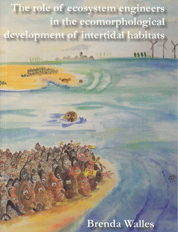
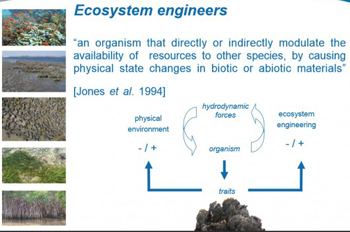 While native oyster restoration is still in its infancy throughout Europe, the value of oyster habitat has not escaped attention. A pilot project in The Netherlands was undertaken to assess the value of non-native Crassostrea gigas reefs in coastal protection. While the final results of this project in the Wadden Sea are yet to be published, the preliminary findings were promising. The native European oyster Ostrea edulis has been functionally extinct in the Wadden Sea for a number of decades, while C. gigas has been increasing in abundance since the 1980s.
While native oyster restoration is still in its infancy throughout Europe, the value of oyster habitat has not escaped attention. A pilot project in The Netherlands was undertaken to assess the value of non-native Crassostrea gigas reefs in coastal protection. While the final results of this project in the Wadden Sea are yet to be published, the preliminary findings were promising. The native European oyster Ostrea edulis has been functionally extinct in the Wadden Sea for a number of decades, while C. gigas has been increasing in abundance since the 1980s.
See Dr. Walles’ recently published papers and presentation:
Walles, B., 2015. The role of ecosystem engineers in the ecomorphological development of intertidal habitats. Ph.D. Thesis, Wageningen University, Wageningen, The Netherlands, 145pp.
Walles, B., J.S. de Paiva, B.C. van Prooijen, T. Ysebaert, and A.C. Smaal, 2015. The ecosystem engineer Crassostrea gigas affects tidal flat morphology beyond the boundary of their reef structures. Estuaries and Coasts 38:941-950.
Walles, B., R. Mann, T. Ysebaert, K. Troost, P.M.J. Herman, and A.C. Smaal, 2015b. Demography of the ecosystem engineer Crassostrea gigas, related to vertical reef accretion and reef persistence. Estuarine, Coastal and Shelf Science 154:224-233.
See presentation by B. Walles
Link for more info
Restoration and Living Shoreline-Related Policies
Final TNC Report on “Shellfish Restoration and Alternative Shoreline Protection Policies of the Southeastern United States: Florida, Georgia, North Carolina and South Carolina” PDF here. Also, the “Coastal Alabama Living Shorelines Policies, Rules, and Model Ordinance Manual” is also now available (see link) or PDF.
Inventory of Shellfish Restoration Permitting & Programs in the Coastal States — a timely summary of shellfish policies in 21 coastal states. Now available (see link) or PDF.
Southern Environmental Law Center (SELC) Living Shorelines: Maintaining Coastlines Naturally Resource Site.
SELC has a highly qualified and dedicated team of attorneys working out of nine offices throughout the Southeast and on Capitol Hill. The “Living Shorelines” Initiative has been a focus since 2012.
Gulf Coastal Resilience: Informing the identification of restoration projects with maximum socio-economic and ecological benefits
Coastal Protection Tool
Re-engineering the Gulf of Mexico using nearshore wave modeling to abate coastal erosion by prioritizing the most economically and ecologically valuable sites for restoration of oyster reefs. (link).

The Nature Conservancy and partners including the Natural Capital Project, NOAA, USGS, University of Southern Mississippi, United Nations University, and the Association of State Floodplain Managers are advancing a global network for Coastal Resilience to support adaptation planning and post-storm redevelopment decisions. The network includes a local to global decision support tool for examining social, economic, and ecological priorities alongside data on coastal hazards. (link)
DECISION SUPPORT TOOL FOR SHORELINE PROTECTION ALONG THE TX GULF INTRACOASTAL WATERWAY
Ducks Unlimited Southern Regional Office GIS Services
Through the use of GIS and aerial imagery, Ducks Unlimited has developed a decision support tool for landowners, agencies, private industry and conservation organizations to use for identifying immediate threats to coastal marshes and for prioritizing implementation of breakwaters as funding becomes available. (link) (pdf)
Program for the Study of Developed Shorelines
Dr. Rob Young, Director, Program for the Study of Developed Shorelines, Western Carolina University
![]() Related News, Articles and Media link
Related News, Articles and Media link
Living Shorelines Database (Coasts, Oceans, Ports and Rivers Institute)
New database of existing “living shoreline” projects around the United States (American Society of Civil Engineers).
![]() Living Shorelines Database link
Living Shorelines Database link
The Venice Project

Building with Nature for Environmental Restoration and Resilient Storm Surge Protection
Link
State of the Science Workshop: Shoreline Armoring and Related Impacts
Shipman, H., Dethier, M.N., Gelfenbaum, G., Fresh, K.L., and Dinicola, R.S., eds., 2010, Puget Sound Shorelines and the Impacts of Armoring—Proceedings of a State of the Science Workshop, May 2009: U.S. Geological Survey Scientific Investigations Report 2010–5254, 266 p. PDF
Examples in MD
- Virginia Institute of Marine Science (Center for Coastal Resource Management) living shoreline resources
- A Handbook for estuarine property owners on shoreline stabilization options–Weighing your options
- Maryland Department of Natural Resources has debuted a new living shorelines website
Focus on NC Living Shoreline Efforts
- NC Estuarine Shoreline Stabilization: Living Shorelines Training Summary
- Info on NC’s cost share program for sill projects (through Soil Conservation Districts)
- NC General Permit for sill/marsh plantings
- NC General Permit for marsh toe revetments (low profile sills, no fill)
- NC General Permit for sheetpile sills
- NC Division of Coastal Management-Agency organized field evaluation of sill projects in NC
- NC Scientific Committee Report on Shoreline Stabilization Options in NC-“Recommendations For Appropriate Shoreline Stabilization Methods For The Different North Carolina Estuarine Shoreline Types”-2006
Delaware Bay LS Projects
Tidal marshes are vital to the overall health of the Delaware Estuary. They act as the estuary’s “kidneys” filtering vast volumes of water. They also provide a variety of animals with spawning sites, nurseries, foraging areas, and nesting grounds and when the estuary’s waters rise, marshes act like sponges, retaining floodwaters and buffering against powerful storm surges. Delaware Bay’s tidal marshes are being lost or degraded due to a variety of factors. One of these is erosion associated with sea level rise and boat wakes. Marshes often cannot keep pace. Another widespread problem is the degradation of interior marsh areas. One technique that may help marshes keep pace is to work with nature to enhance or restore shellfish reefs that line the edges of wetlands. Such communities are often capable of buffering marshes from wave action, slowing erosion, and buying more time for marshes to accumulate in place (vertical accretion) or move inland (horizontal relocation).
What is the Delaware Estuary Living Shoreline Initiative (DELSI)?
The DELSI is a pilot project designed to stabilize eroding shorelines of tidal marshes. It is developing methods using intertidal shellfish such as ribbed mussels to form a natural breakwater. This “living shoreline” approach traps sediment and absorbs waves that would otherwise wash away fragile aquatic plants. The goal of this project is to provide an economical approach to communities in the Delaware Estuary that are struggling to combat the erosion of their tidal marshes. The related group (the Partnership for the Delaware Estuary) has created a Practitioners Guide to Constructing Living Shorelines.
In related work:
- “Stretch along Maurice River in Cumberland Becomes a Living Shoreline” (link)
-
Scientists Flex Mussels to Protect Shorelines
David Bushek, Ph.D., Associate Professor, Rutgers University, and Danielle Kreeger, Ph.D., Science Director, Partnership for the Delaware Estuary. pdf
Living Shorelines along the Georgia Coast: A summary report of the first Living Shoreline projects in Georgia, 2013.
Georgia Department of Natural Resources, 48pp. pdf
Living Shoreline Restoration Project: Altamaha-Ogeechee Estuarine Complex, GA. Alternative estuarine erosion control and implementation
The Stability of Living Shorelines – An Evaluation
This Final 2007 Report Submitted to NOAA’s Chesapeake Bay Program Office, Annapolis, MD. Submitted by the Center for Coastal Resources Management (CCRM) VIMS and the College of William and Mary, Gloucester Point, VA.
The report, as well as outreach material collected as part of this project and others within the Center for Coastal Resources Management have been posted to a new Living Shoreline Website at http://ccrm.vims.edu/livingshorelines/index.html.
http://ccrm.vims.edu/
Coastal Resilience and Mapping (Natural Coastal Protection: Coastal Ecosystems Reducing Risks From Natural Hazards & Climate Change)
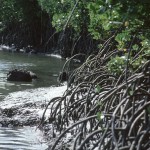 The Nature Conservancy is working on multiple fronts to help people adapt to climate change and to the impacts of natural disasters. In many ways the coastal zone represents the front line for this adaptation. Lives, livelihoods, homes and agriculture are already feeling the impacts of rising seas and changing weather patterns. In some places nature can help to protect coastlines from erosion and the ravages of storms. TNC’s Natural Coastal Protection Project (now Coastal Resilience) is a collaborative work to review the growing body of evidence as to how, and under what conditions natural ecosystems can and should be worked into strategies for coastal protection. This site is intended to be a dynamic portal for that work, communicating to partners and practitioners, explaining the science, providing more detailed scientific reviews as downloads, and linking to the work of partners and to other related work. For mangroves and other habitats, including oysters.
The Nature Conservancy is working on multiple fronts to help people adapt to climate change and to the impacts of natural disasters. In many ways the coastal zone represents the front line for this adaptation. Lives, livelihoods, homes and agriculture are already feeling the impacts of rising seas and changing weather patterns. In some places nature can help to protect coastlines from erosion and the ravages of storms. TNC’s Natural Coastal Protection Project (now Coastal Resilience) is a collaborative work to review the growing body of evidence as to how, and under what conditions natural ecosystems can and should be worked into strategies for coastal protection. This site is intended to be a dynamic portal for that work, communicating to partners and practitioners, explaining the science, providing more detailed scientific reviews as downloads, and linking to the work of partners and to other related work. For mangroves and other habitats, including oysters.
Reduction of Wind and Swell Waves by Mangroves
McIvor, A.L., I. Möller, T. Spencer, and M. Spalding, 2012. Reduction of wind and swell waves by mangroves. Natural Coastal Protection Series: Report 1. Cambridge Coastal Research Unit Working Paper 40. Published by The Nature Conservancy and Wetlands International, 27pp.
Bio-Engineered Oyster Reef Demonstration (LA-08)
Location: The project is located along the Rockefeller Wildlife Refuge Gulf of Mexico shoreline west of Joseph Harbor canal in Cameron Parish, Louisiana
Project Type: Demonstration: Shoreline Protection
Local Sponsor: Coastal Protection and Restoration Authority, Baton Rouge, LA (CWPPRA)
Site Info: see
- http://lacoast.gov/new/Projects/Info.aspx?num=la-08
- LA-08 General Project Fact Sheet
- http://wayfarertech.com/projects/rockefeller-refuge
Living Shoreline webinar, hosted on March 21, 2013 by Georgetown Climate Center, link below.
Jessica Grannis, staff attorney for the Georgetown Climate Center, and Georgetown Law student Bari Greenfeld discuss the Center’s recent analysis of how to integrate living shorelines into the different regulatory frameworks that govern projects in intertidal areas: Section 404 of Clean Water Act and state coastal and wetlands laws.
See http://www.georgetownclimate.org/preparing-for-climate-changes-with-living-shorelines
Conventional and alternative shoreline control techniques and associated environmental impacts: annotated bibliography
Compiled and Written by Bran Wagner, School of Renewable Natural Resources, Louisiana State University AgCenter, Baton Rouge, LA 70803
U.S. ARMY CORPS OF ENGINEERS GENERAL PERMITS FOR MINOR STRUCTURES AND ACTIVITIES WITHIN THE STATE OF ALABAMA GENERAL PERMIT FOR WORK IN OUTER CONTINENTAL SHELF WATERS OFF THE COAST OF ALABAMA
http://www.sam.usace.army.mil/Missions/Regulatory/SourceBook/AlabamaGeneralPermits.aspx
http://www.habitat.noaa.gov/restoration/techniques/agcregulationspermits.html
U.S. ARMY CORPS OF ENGINEERS GENERAL PERMITS FOR MINOR STRUCTURES AND ACTIVITIES WITHIN THE STATE OF MS GENERAL PERMIT FOR LIVING SHORELINES MSGP-03- LIVING SHORELINES (SAM-2010-01343-SPG)
Effective: 12 April 2013 Expiration: 12 April 2018
https://allselc.box.com/s/y987jbkbfxakry5kbzzr and Pdf
ARMY CORPS OF ENGINEERS’ CHARLESTON DISTRICT’S GENERAL PERMIT FOR OYSTER REEF RESTORATION AND/OR CREATION PROJECTS CONSTRUCTED FOR SHORELINE AND MARSH STABILIZATION.
Uniquely, it:
- Is limited to projects sponsored by South Carolina Department of Natural Resources
- Does not cover shoreline and marsh stabilization projects using “oyster castles, reef balls, and other similar structures”
- Requires navigational markers for certain structures.
Implementing Our Living Shorelines Project
(see http://www.southernenvironment.org/cases/living_shorelines/)
Southern Environmental Law Center’s (SELC) Living Shorelines roundtables began in September 2012 (see agenda, https://allselc.app.box.com/s/y987jbkbfxakry5kbzzr), bringing together 50 of our partners and national and regional policymakers to promote the use of living shorelines as an alternative to seawalls and bulkheads. Collaborating with the U.S. Environmental Protection Agency, the Corps of Engineers, the U.S. Fish and Wildlife Service, coastal groups, and others that are part of our project, we shared ideas and strategies for supporting the use of living shorelines. Additional Living Shorelines conferences are planned.. The 3rd Living Shorelines conference was held near Mobile, AL, on August 21, 2013 bringing together partner groups, researchers and federal and state agencies to discuss ways to most effectively incorporate coastal engineering and ecological approaches into the creation of effective living shorelines. As an outcome of our conference, a team of scientists, engineers, and others will be seeking funding for and developing a code book to describe living shorelines and the criteria for their design.
TNC-NOAA effort near Mobile Bay, AL
Recent Research on Living Shorelines In Alabama
Scyphers, S.B., S.P. Powers, K.L. Heck, Jr.., and D. Byron, 2011. Oyster reefs as natural breakwaters mitigate shoreline loss and facilitate fisheries. PLoS ONE 6(8):e22396. doi:10.1371/journal.pone.0022396
MS/AL TNC Living Shoreline Overview
An overview (pdf) by Jeff DeQuattro (TNC) of various approaches taken by TNC and its partners in the Gulf of Mexico, especially Mobile Bay and adjacent waters for reef building, living shorelines and related erosion control.
http://www.behance.net/gallery/TNC-Oyster-Reef-Restoration/3979955 for video of these approaches.
Coffee Island in Mobile Bay had been slowly disappearing for decades, but an effort by NOAA and TNC has quit its shrinking. In fact, there are signs that the island, located just south of Bayou La Batre in the Mississippi Sound, is starting to grow larger. Credit goes to a “living shoreline” experiment dreamt up by the Nature Conservancy and funded by the National Oceanic and Atmospheric Administration. Using a federal stimulus fund grant in 2010, the groups constructed a series of oyster reefs around the southeast side of the island in an effort to combat erosion of the marsh.
See: “Coffee Island oyster restoration project more successful than designers imagined”
Examples in FL
The City of Gulf Breeze’s Deadman’s Island Restoration Project
The loss of coastal barrier habitat in Pensacola Bay has reduced natural habitat for fishing, and paddleboarding, boating, hiking, kayaking and exploring. The Deadman’s Island Restoration project addresses the loss of wildlife (aquatic and terrestrial) habitat. Seven acres of salt marsh have been lost from erosion including a deficit in the amount of sediment available to renourish the area. Due to this loss of marsh, native oyster habitat has declined. To slow down erosion breakwaters with materials such as Reefblk and Ecodiscs with oyster shell were deployed to create a more stable area for wetlands to recover in the face of underwater currents and a 12 mile fetch. This project will demonstrate the ability to combine a successful technique of creating vertical reef habitat to dissipate wave energy, and to create essential fish and bird habitat. The transferability of this project to other coastal areas is already being viewed as an alternative to rip rap. Deadman’s island is now a study site for the Army Corps of Engineers, NOAA, several other government agencies and is part of the Case Study Gulf Of Mexico Alliance Governor’s Action Plan for Sediment Management. See website for funding partners.
Southwest Florida Living Shorelines Workshop
Summary of CD Contents, Online Resources, and Publications
TNC Oyster Reef Restoration Animation
The Nature Conservancy asked them to create an interactive infographic to educate people on the importance of oyster reef restoration. Here animated a 3-d model of a typical shoreline. Then the animation shows the process of shoreline deterioration when natural oyster reefs die and are lost and what one can do to strengthen them.
Oyster-tecture
MoMA Rising Currents Exhibition, 2010
We propose to nurture an active oyster culture that engages issues of water quality, rising tides, and community based development around Brooklyn’s Red Hook and Gowanus Canal. An armature for the growth of native oysters and marine life is designed for the shallow waters of the Bay Ridge Flats just south of Red Hook. This living reef is constructed from a field of piles and a woven web of “fuzzy rope” that supports oyster and mussel growth and builds a rich three-dimensional landscape mosaic. A watery regional park for the New York Harbor emerges that prefigures the city’s return to the waterfront in the next century. The reef attenuates waves and cleans millions of gallons of Harbor water through harnessing the biotic processes of oysters, mussels and eelgrass, and enables neighborhood fabrics that welcome the water to develop further inland.
This project represents a vision for the future of the harbor. A small pilot project is currently in development for the Gowanus Bay that will host new forms of marine habitat, with a focus on mussels.
Related Links:
Reviving New York’s rivers — with oysters!
Kate Orff @ TED
http://www.scapestudio.com/projects/oyster-tecture/
On Decimated Shore, a Second Life for Christmas Trees
By Michael Schwirtz, Long Beach, N.Y., NYT February 4, 2013
Plan to restore the protective dunes washed away by Hurricane Sandy using used trees
West Coast (U.S.) Living Shoreline Efforts
The San Francisco Bay Living Shorelines: Nearshore Linkages Project
State Coastal Conservancy, along numerous state, federal, and non-profit partners initiated a native oyster and eelgrass restoration effort in San Francisco Bay. The overall project is composed of two types of experiments: “Larger scale” experiments to test biological and physical effects of treatment plots, and smaller “substrate” experiments to test the biological effects of different substrates or surfaces that could be used on a larger scale in future projects. It is using a variety of oyster settlement (substrate units) approaches including: shell bags, “layer cakes”, reef balls, reef castles, etc. It also includes site selection criteria, substrate experiments at several locations. It also involves eelgrass restoration and interactions with oyster reefs.
- See general site link
- press release
- Project overview (see link)








